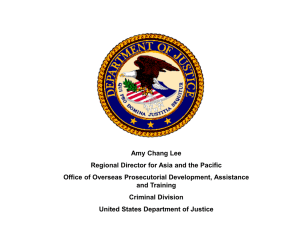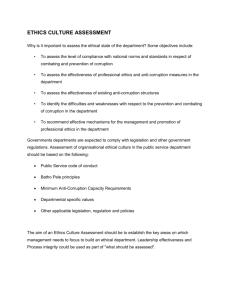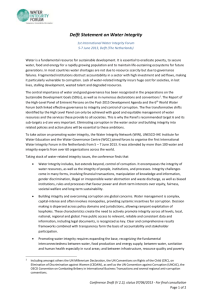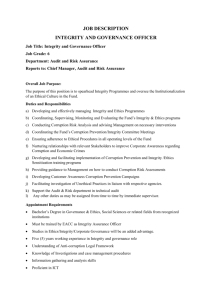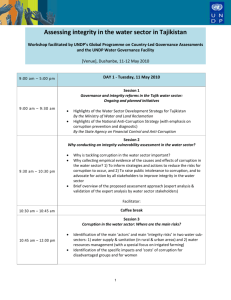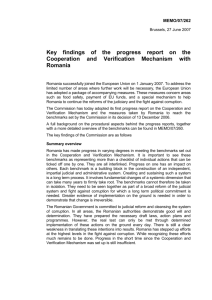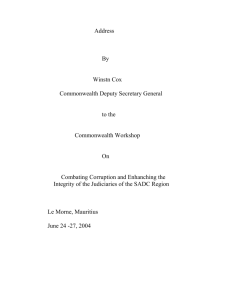HR/SEL/GG/SEM/2004/BP.8 page 1 SEMINAR ON GOOD
advertisement
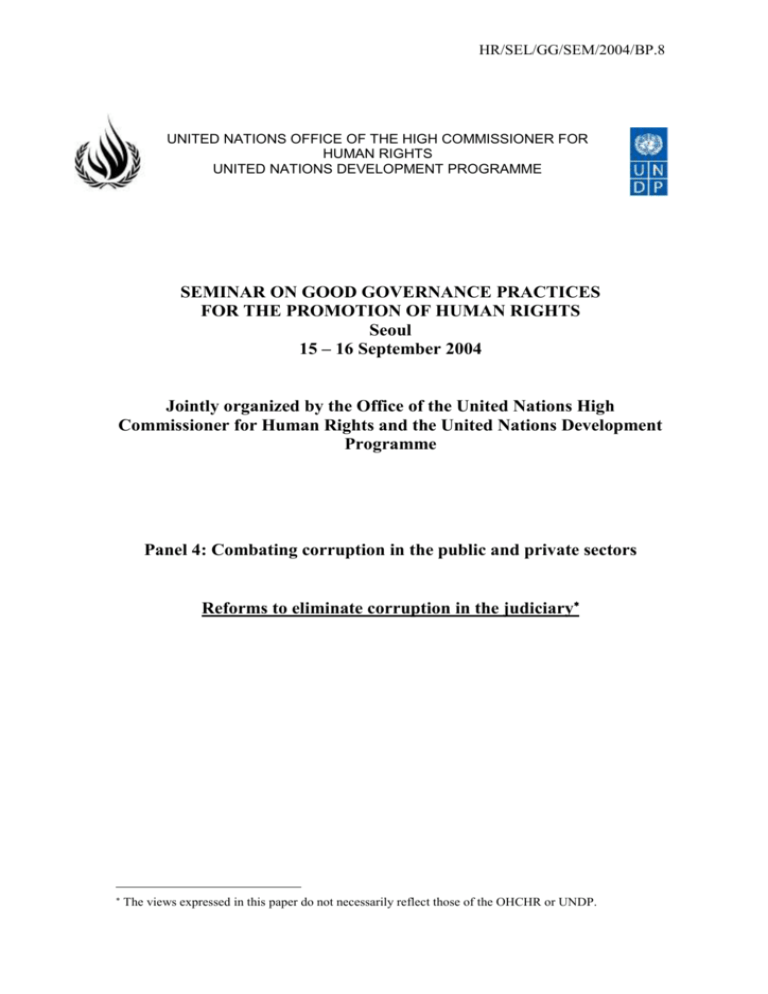
HR/SEL/GG/SEM/2004/BP.8 UNITED NATIONS OFFICE OF THE HIGH COMMISSIONER FOR HUMAN RIGHTS UNITED NATIONS DEVELOPMENT PROGRAMME SEMINAR ON GOOD GOVERNANCE PRACTICES FOR THE PROMOTION OF HUMAN RIGHTS Seoul 15 – 16 September 2004 Jointly organized by the Office of the United Nations High Commissioner for Human Rights and the United Nations Development Programme Panel 4: Combating corruption in the public and private sectors Reforms to eliminate corruption in the judiciary The views expressed in this paper do not necessarily reflect those of the OHCHR or UNDP. HR/SEL/GG/SEM/2004/BP.8 page 2 Reforms to eliminate corruption in the judiciary in Kenya Presentation Abstract Summary 1. Kenya’s anti-corruption reform agenda is part of its on-going constitutional reform process. Under the draft constitution 2004 the Republic of Kenya is founded on the principles of good governance through multiparty democracy, participatory governance, transparency and accountability, separation and devolution of powers, respect for human rights and fundamental freedoms and the rule of law. 2. Kenya’s anti-corruption plan is supported by seven pillars, namely leadership and political will; institutional reforms; legal reforms; transitional justice measures addressing the past; the role of the private sector; the role of civil society and the media; and partnerships with the international community. 3. A number of institutions have been created or reformed to limit corruption. The Ministry of Justice and Constitutional Affairs chairs the inter-ministerial Cabinet Committee on Corruption. The Ministry’s principal functions include the formation of legal policy, law and legal sector reform and collaboration with anti-corruption bodies on reform strategies and implementation. The Committee advises the President on anticorruption initiatives and principles of better governance. It is the responsibility of the Department of Governance and Ethics to implement measures to reduce corruption and promote greater transparency and accountability in the conduct of national affairs. In 2003 the Anti-Corruption and Economic Crimes Act created the Kenya Anti-Corruption Commission. The Commission investigates corruption and economic crimes, performs public education functions, institutes civil proceedings for the recovery of public property, and advises other public institutions on practices and procedures that reduce corruption. 4. The main concerns calling for a judicial reform in Kenya were accessibility to justice, both in terms of geographical and financial accessibility; lack of independence, efficiency, competence and effectiveness of the judiciary; and devolving and decentralizing judicial power from the Chief Justice. 5. An independent, impartial and informed judiciary is considered to hold a central place in the realization of a just, open and accountable government. Institutional reform of the judiciary was therefore an immediate priority for the Government. 6. A Committee on Reform and Development of the Judiciary was appointed by the new Chief Justice and a sub-committee on Integrity and Anti-Corruption set up, which resulted in far-reaching judicial reforms. The Committee determined that six judges in the Court of Appeal, 17 in the High Court and 82 magistrates had been involved in acts of corruption. According to the Committee corruption included demanding and accepting cash bribes; sexual favours; free transports, hospitality and other gifts in return for partisan judgments; fraud through not accounting for money received, fiddling official receipts and stealing exhibits and abuse of office by doctoring evidence and giving promotions through patronage rather than merit. 7. The Committee made the following recommendations: - Improvement of the terms and conditions of service for magistrates and paralegal staff; HR/SEL/GG/SEM/2004/BP.8 page 3 - - Institutional governance measures including recruitment and promotions based on merit; Discontinuation of the practice of retaining retired officers on contract; A corruption hostile deployment and transfer policy; Elimination of conflict of interest situations through the medium of an enforceable code of conduct; Elimination of minimization of delay in hearing and determination of cases; Effective supervisions of judicial staff; A transparent and corruption free allocation of judicial work; Ready availability of files and records by expansion of and computerization of court registries and automation of proceedings; Creation of a corruption hostile legal regime and an enabling environment; Expansion of court facilities countrywide; The recruitment of more judges and magistrates; A reduction in the cost of litigation; and - The strengthening of judicial independence. - Results 8. The reform led to the appointment of a new Registrar and a new Chief Justice. Since the resignation of the former Chief Justice, 42 judicial officers have resigned or been dismissed on suspicion of corruption. Two tribunals were set up to investigate the judges and the named judges were suspended awaiting the investigations by the tribunals. 9. The draft Constitution provides for independence of the judiciary, and lays down provisions for the roles and powers of the Chief Justice and appointment of judges ad well as removal from office and the powers of the Judicial Service Commission. 10. The Kenya Bribery Index 2004 survey (Transparency International) indicates a very significant decrease in petty corruption as compared to 2002.1 The survey also indicates a very significant reduction in the cost of birbery to citizens.2 The judiciary is ranked as one of the most improved organizations of the twenty worst ranked in 2002. Lessons Learned 11. Given that the reform process is an on-going one it may be premature to draw final conclusions and lessons from the reform process. It is important, however to underline that the rule of law and human rights, including the right to a fair trial, remain fully applicable at all times. ----- 1 The percentage of encounters in which bribes were demanded or offered declined from 65 to 40 percent. From an average of 3,905 Kenyan Shillings (approximately 48 USD) per person per month to 1,261 Kenyan Shillings (approximately 15,5 USD). 2


